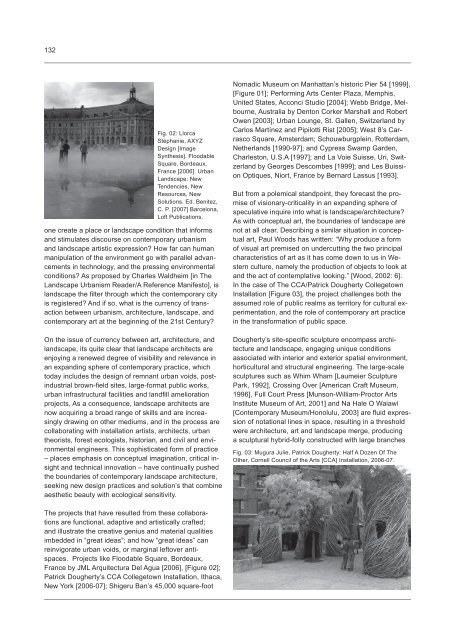Landscape – Great Idea! X-LArch III - Department für Raum ...
Landscape – Great Idea! X-LArch III - Department für Raum ...
Landscape – Great Idea! X-LArch III - Department für Raum ...
Create successful ePaper yourself
Turn your PDF publications into a flip-book with our unique Google optimized e-Paper software.
132<br />
Fig. 02: Llorca<br />
Stéphanie, AXYZ<br />
Design [Image<br />
Synthesis]. Floodable<br />
Square, Bordeaux,<br />
France [2006]. Urban<br />
<strong>Landscape</strong>: New<br />
Tendencies, New<br />
Resources, New<br />
Solutions. Ed. Benitez,<br />
C. P. [2007] Barcelona,<br />
Loft Publications.<br />
one create a place or landscape condition that informs<br />
and stimulates discourse on contemporary urbanism<br />
and landscape artistic expression? How far can human<br />
manipulation of the environment go with parallel advancements<br />
in technology, and the pressing environmental<br />
conditions? As proposed by Charles Waldheim [in The<br />
<strong>Landscape</strong> Urbanism Reader/A Reference Manifesto], is<br />
landscape the filter through which the contemporary city<br />
is registered? And if so, what is the currency of transaction<br />
between urbanism, architecture, landscape, and<br />
contemporary art at the beginning of the 21st Century?<br />
On the issue of currency between art, architecture, and<br />
landscape, its quite clear that landscape architects are<br />
enjoying a renewed degree of visibility and relevance in<br />
an expanding sphere of contemporary practice, which<br />
today includes the design of remnant urban voids, postindustrial<br />
brown-field sites, large-format public works,<br />
urban infrastructural facilities and landfill amelioration<br />
projects, As a consequence, landscape architects are<br />
now acquiring a broad range of skills and are increasingly<br />
drawing on other mediums, and in the process are<br />
collaborating with installation artists, architects, urban<br />
theorists, forest ecologists, historian, and civil and environmental<br />
engineers. This sophisticated form of practice<br />
<strong>–</strong> places emphasis on conceptual imagination, critical insight<br />
and technical innovation <strong>–</strong> have continually pushed<br />
the boundaries of contemporary landscape architecture,<br />
seeking new design practices and solution’s that combine<br />
aesthetic beauty with ecological sensitivity.<br />
Nomadic Museum on Manhattan’s historic Pier 54 [1999],<br />
[Figure 01]; Performing Arts Center Plaza, Memphis,<br />
United States, Acconci Studio [2004]; Webb Bridge, Melbourne,<br />
Australia by Denton Corker Marshall and Robert<br />
Owen [2003]; Urban Lounge, St. Gallen, Switzerland by<br />
Carlos Martínez and Pipilotti Rist [2005]; West 8’s Carrasco<br />
Square, Amsterdam; Schouwburgplein, Rotterdam,<br />
Netherlands [1990-97]; and Cypress Swamp Garden,<br />
Charleston, U.S.A [1997]; and La Voie Suisse, Uri, Switzerland<br />
by Georges Descombes [1999]; and Les Buission<br />
Optiques, Niort, France by Bernard Lassus [1993].<br />
But from a polemical standpoint, they forecast the promise<br />
of visionary-criticality in an expanding sphere of<br />
speculative inquire into what is landscape/architecture?<br />
As with conceptual art, the boundaries of landscape are<br />
not at all clear. Describing a similar situation in conceptual<br />
art, Paul Woods has written: “Why produce a form<br />
of visual art premised on undercutting the two principal<br />
characteristics of art as it has come down to us in Western<br />
culture, namely the production of objects to look at<br />
and the act of contemplative looking.” [Wood, 2002: 6].<br />
In the case of The CCA/Patrick Dougherty Collegetown<br />
Installation [Figure 03], the project challenges both the<br />
assumed role of public realms as territory for cultural experimentation,<br />
and the role of contemporary art practice<br />
in the transformation of public space.<br />
Dougherty’s site-specific sculpture encompass architecture<br />
and landscape, engaging unique conditions<br />
associated with interior and exterior spatial environment,<br />
horticultural and structural engineering. The large-scale<br />
sculptures such as Whim Wham [Laumeier Sculpture<br />
Park, 1992], Crossing Over [American Craft Museum,<br />
1996], Full Court Press [Munson-William-Proctor Arts<br />
Institute Museum of Art, 2001] and Na Hale O Waiawi<br />
[Contemporary Museum/Honolulu, 2003] are fluid expression<br />
of notational lines in space, resulting in a threshold<br />
were architecture, art and landscape merge, producing<br />
a sculptural hybrid-folly constructed with large branches<br />
Fig. 03: Mugura Julie, Patrick Dougherty: Half A Dozen Of The<br />
Other, Cornell Council of the Arts [CCA] Installation, 2006-07.<br />
The projects that have resulted from these collaborations<br />
are functional, adaptive and artistically crafted;<br />
and illustrate the creative genius and material qualities<br />
imbedded in “great ideas”; and how “great ideas” can<br />
reinvigorate urban voids, or marginal leftover antispaces.<br />
Projects like Floodable Square, Bordeaux,<br />
France by JML Arquitectura Del Agua [2006], [Figure 02];<br />
Patrick Dougherty’s CCA Collegetown Installation, Ithaca,<br />
New York [2006-07]; Shigeru Ban’s 45,000 square-foot
















